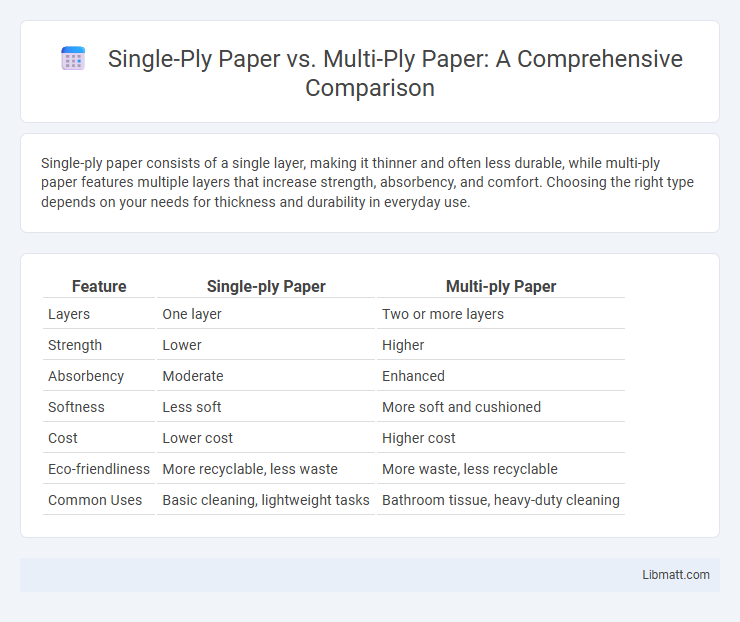Single-ply paper consists of a single layer, making it thinner and often less durable, while multi-ply paper features multiple layers that increase strength, absorbency, and comfort. Choosing the right type depends on your needs for thickness and durability in everyday use.
Table of Comparison
| Feature | Single-ply Paper | Multi-ply Paper |
|---|---|---|
| Layers | One layer | Two or more layers |
| Strength | Lower | Higher |
| Absorbency | Moderate | Enhanced |
| Softness | Less soft | More soft and cushioned |
| Cost | Lower cost | Higher cost |
| Eco-friendliness | More recyclable, less waste | More waste, less recyclable |
| Common Uses | Basic cleaning, lightweight tasks | Bathroom tissue, heavy-duty cleaning |
Introduction to Single-Ply and Multi-Ply Paper
Single-ply paper consists of a single layer, making it lightweight and cost-effective for everyday use, while multi-ply paper features two or more layers bonded together, offering enhanced strength and absorbency for more demanding applications. The choice between single-ply and multi-ply paper impacts durability, texture, and overall performance in various settings such as bathrooms, kitchens, or commercial spaces. Understanding the differences helps you select the right paper based on your specific needs for comfort and efficiency.
Key Differences Between Single-Ply and Multi-Ply Paper
Single-ply paper consists of a single layer of tissue, offering a thinner, less absorbent texture ideal for light use and budget-friendly options. Multi-ply paper involves two or more layers, providing enhanced strength, softness, and absorbency suited for higher durability and comfort needs. Understanding these key differences helps you select the appropriate paper based on usage frequency, softness preference, and environmental considerations.
Durability and Strength Comparison
Single-ply paper typically offers less durability and strength compared to multi-ply paper due to its single layer composition, which can tear more easily under pressure or moisture. Multi-ply paper, composed of two or more layers, provides enhanced thickness, tensile strength, and resistance to tearing, making it ideal for heavy-duty tasks and prolonged use. When selecting paper for your needs, consider multi-ply options for increased durability and reliability in demanding applications.
Absorbency and Performance
Single-ply paper offers moderate absorbency suitable for everyday tasks, while multi-ply paper provides superior absorbency and durability due to its layered structure. Multi-ply options excel in performance for handling liquids and cleaning, reducing the need for multiple sheets and ensuring efficiency. Your choice should consider the balance between absorbency level and strength depending on the task requirements.
Cost Efficiency: Single-Ply vs Multi-Ply
Single-ply paper typically offers greater cost efficiency due to lower manufacturing expenses and reduced material usage, making it an economical choice for high-volume applications. Multi-ply paper, while more expensive, provides enhanced absorbency and strength, which can reduce overall usage and waste in situations requiring durability. Your decision should weigh the upfront cost savings of single-ply against the potential long-term savings and performance benefits of multi-ply options.
Environmental Impact and Sustainability
Single-ply paper generally has a lower environmental impact due to reduced raw material usage and less energy-intensive manufacturing compared to multi-ply paper. Multi-ply paper, while offering increased durability and absorbency, often requires more fibers and chemicals, leading to higher resource consumption and waste generation. Sustainable sourcing of fibers and recycling practices are critical in minimizing the ecological footprint of both single-ply and multi-ply paper products.
Comfort and User Experience
Single-ply paper offers a thinner texture that can sometimes feel less soft, impacting comfort during use, while multi-ply paper provides enhanced softness and cushioning due to its multiple layers. The increased thickness of multi-ply paper improves durability and reduces the likelihood of tearing, contributing to a more pleasant user experience. Your choice between single-ply and multi-ply paper affects personal comfort and satisfaction, especially in frequent or sensitive use scenarios.
Applications and Common Uses
Single-ply paper is commonly used in applications where cost-efficiency and basic absorbency are sufficient, such as office printing, flyers, and lightweight packaging. Multi-ply paper offers enhanced strength and absorbency, making it ideal for paper towels, napkins, and hygiene products requiring durability and softness. Your choice between single-ply and multi-ply paper should consider the specific functional requirements of your application to ensure optimal performance.
Choosing the Right Type for Your Needs
Single-ply paper offers a thinner, more economical option ideal for light use and quick tasks, while multi-ply paper provides enhanced durability and absorbency suitable for heavy-duty or high-traffic environments. Your choice depends on factors like the required strength, comfort, and cost-efficiency, with multi-ply types often found in settings demanding superior performance. Evaluate your specific needs to balance sustainability and functionality when selecting between these paper varieties.
Conclusion: Which Paper is Best?
Single-ply paper offers cost-effectiveness and simplicity suitable for environments with light usage, while multi-ply paper provides enhanced strength, absorbency, and durability making it ideal for heavy-duty cleaning tasks. Businesses prioritizing longevity and reduced waste often prefer multi-ply options due to their higher performance and user satisfaction. The best choice depends on specific needs like budget constraints, usage intensity, and desired tissue quality.
Single-ply paper vs multi-ply paper Infographic

 libmatt.com
libmatt.com